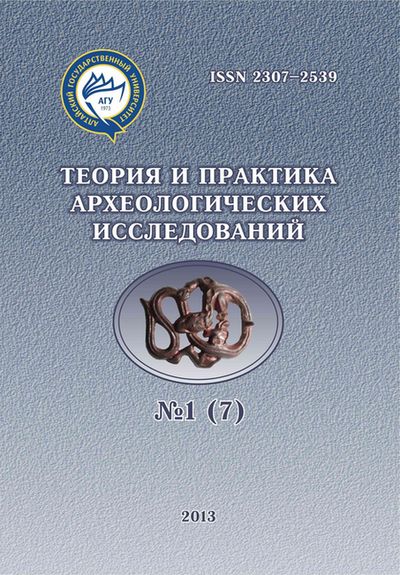INVESTIGATION OF CHINESE LAC QUERED CUPS , THE HAN DYNASTY PERIOD FROM THE STATE HERMITAGE (Russia)
DOI:
https://doi.org/10.14258/tpai(2013)1(7).-09Keywords:
archaeological lacquers from the collection of the State Hermitage, products with varnish of the Han dynasty mounds Noin-Ula, cups with handles (er Bay), paints based on the urushiol, qi-lacquer, modification, tung oil, natural oil phenolic composite physico-chemical methods, infrared spectroscopy, X-ray analysis, attributionAbstract
The State Hermitage Museum presents a unique collection of Chinese lacquer ware from the Han Dynasty. These were found in the opened barrows of Xiongnu, in the mountains of Noin-Ula in Northern Mongolia by the expedition 1923–1926 headed by the eminent Russian traveler and explorer of Central Asia, Pyotr Kozlov (1863–1935).The article examines the collection of artifacts – Chinese cups with handles (er-Bay) identified by the different time of burials in Noin-Ula (between 2 BC – the end of the 1st century AD).The investigation uses a combination of art history and technological approaches for the study of their coatings. The characteristics of the paintings, were studied and compared with the technological features of the materials and their colours.The chemical composition and structure of the varnishes and paints exhibits were studied by physicochemical methods (microscopy, infrared spectroscopy and the X-ray analysis). It was established that multilayer coating exhibits from Noin-Ula were made with a specific technique using the natural material extracted from the sap of the lacquer tree (Latin Rhus verniciflua), Chinese Qi Shu (漆树, Engl. qi-lacquer, Jap. urushi). Its foundation is based on the biopolymer pyrocatechols urushiol. The role of tung oil (Tun chzhóu, 桐油) in the compositions and studied samples of qi-lacquer was also examined. An integrated approach to the study of the Noin-Ula collection of lacquer cups from the State Hermitage, allows specifying the destination range (high income or consumer goods), cultural and chronological attribution and confirming their dating.
Downloads
References
Лубо-Лесниченко Е.И. Китайские лаковые изделия из Ноин-Улы // Тру-ды Государственного Эрмитажа. 1969. Т. 10, вып. 7, с. 267–277.
Письма А.Д. Симукова к П.К. Козлову и Е.В. Козловой. Публикация Юсуповой Т. И., Симуковой Н. А. // Mongolica, VIII. СПб., 2007, с. 102–109.
Полосьмак Н.В., Богданов Е.С., Цэвэндорж Д. Двадцатый Ноин-улинский курган. Новосибирск: ИНФОЛИО, 2011. 184 с.: ил.
Руденко С.И. Культура хуннов и Ноин-Улинские курганы. М.; Л.: Изд-во АН СССР, 1962. 206 с.
Чистякова А.Н. Иероглифическая надпись на лаковой чашке из кургана №20 в Ноин-Уле (Монголия) // Археология, этнография и антропология Евразии. 2009. №3. С. 59–68.
Bonanni F. Techniques of Chinese Lacquer. Trans. Flavia Perugini. Los Angeles. 2009.
Dschingis Khan und seine Erben. Das Weltreich der Mongolen. Miinchen, 2005.
Lawton T., Fu S., Lowry G., Yonemura A., Beach M. Asian Art in the Ar-thur M. Sackler Gallery. Washington, 1987.
Lui C.Y., Nylan M., Barbieri-Low A. Recarving China’s Past. Art, Archaeology and Architecture of the «Wu Family Shrines». New Haven and London, 2005.
Louis F. Han Lacquerware and the Wine Cups from Noin-Ula // The Silk Road. 2006. V. 4/2.
Miniaev S., Elikhna J. On the Chronology of the Noyon uul Barrows // The Silk Road. 2009. Vol. 7. Р. 21–31.
Pirazzoli-t’Serstevens M. Chinese Lacquerware from Noyon uul: Some Problems of Manufacturing and Distribution. // The Silk Road. Vol. 7. 2009.
Umehara S. Studies of Noin-Ula Finds in North Mongolia.// Тhe Toyo Bunko Publications Series A. Tokyo, 1960. № 27.


